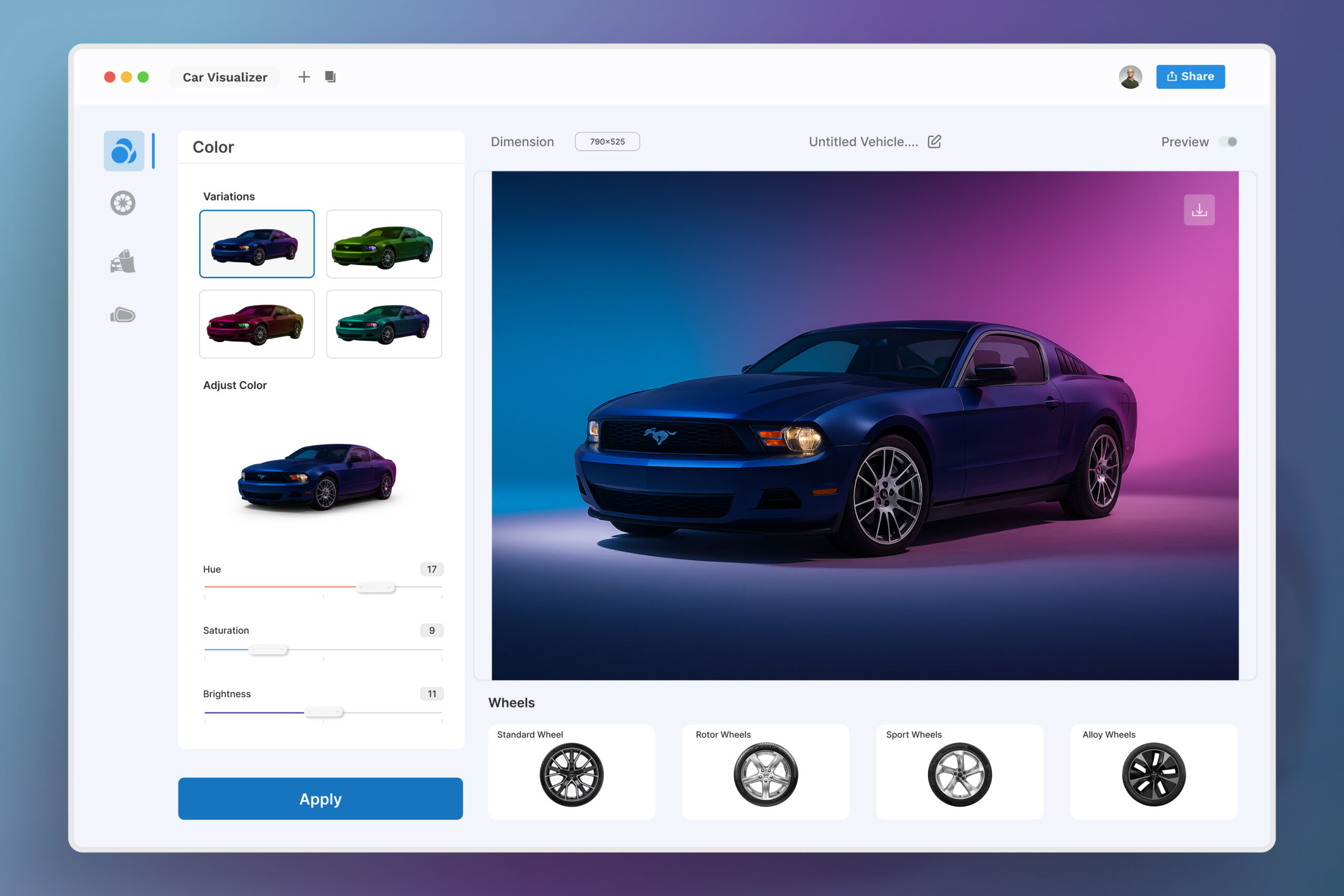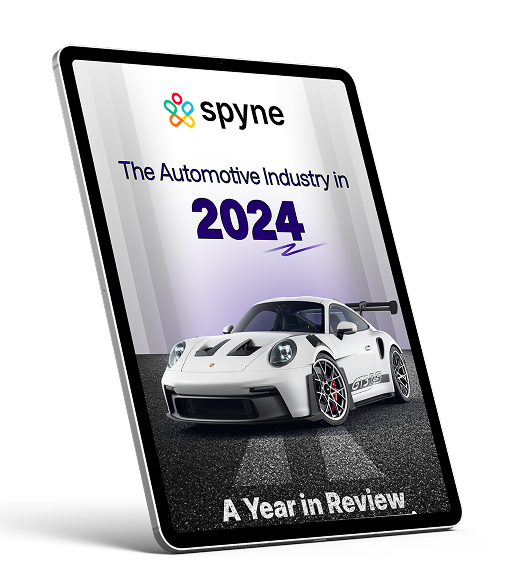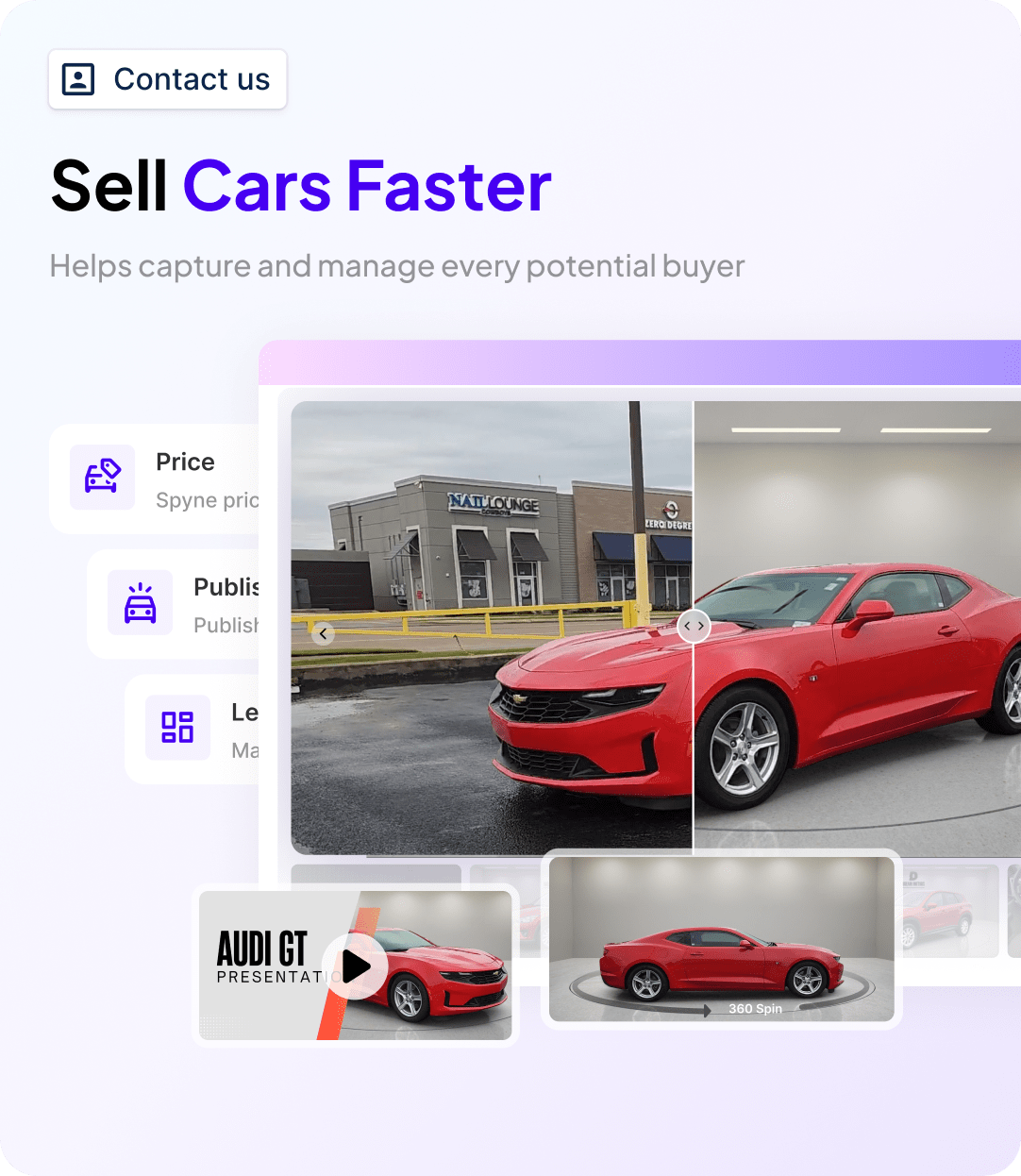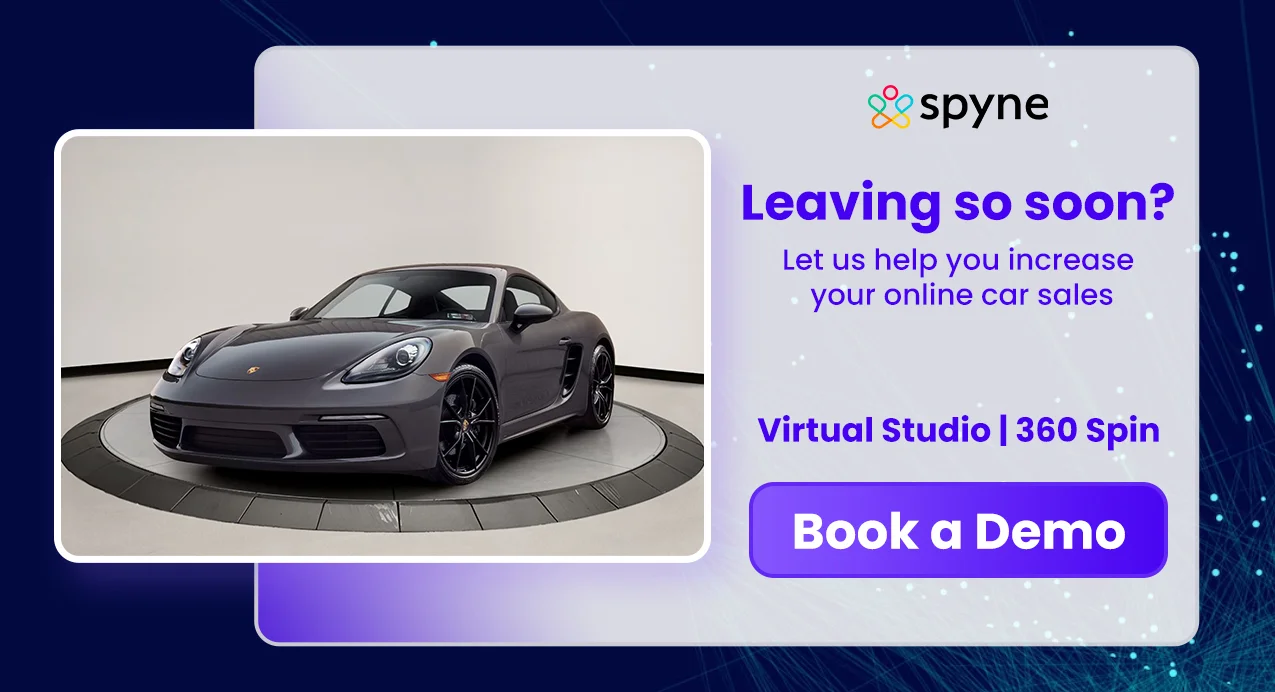Have you ever thought of what tomorrow’s cars would look like? Now imagine yourself customizing the car’s paint, rims, interiors and much more. Sounds unbelievable, right? You can do this with a modern car visualizer. In this 2025 guide, let’s understand what is a car visualizer, how it works, why you should use it, what features are you in for, and how to use the tool. So sit back as we unfold what is a car visualizer.
What Is a Car Visualizer?
A car visualizer is a web or app-based tool and lets you visualize vehicles on the go. When you ask what is a car visualizer, you might come up with answers like it is virtual showroom. That’s right! You can pick a model or upload yours, change colors, customize wheels, view the vehicle in 3D or AR and get a peak at your dream car before it is present in real life.
Key capabilities when wondering what is a car visualizer:
- Change exterior paint colors and finishes using tools like Spyne’s car color changer for instant previews.
- Customize car wheels and accessories
- Change interiors, features, and trims
- Rotate and zoom in a 360° view or even see it in AR.
- See price updates as you build your configuration
By mid‑2025, many dealerships and automakers have embedded these on websites. Car buyers no longer scroll static images, they interact, explore, and configure in immersive detail.
Why It Matters in 2025: The Value of a Car Visualizer
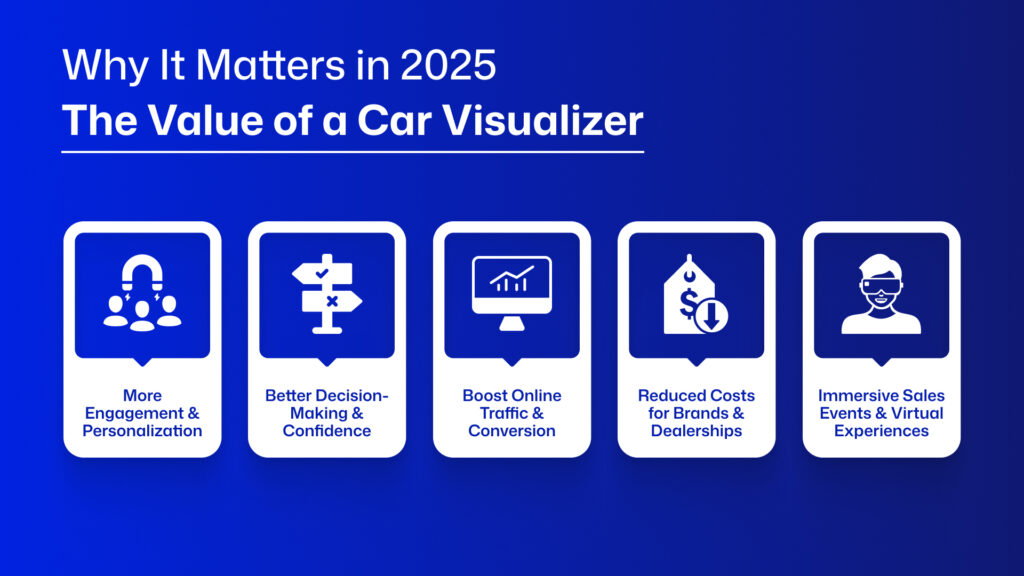
More Engagement & Personalization
The shoppers of today expect more than just images while buying a product; they expect control over it. A car visualizer gives that control to the consumer by allowing them to do experimental browsing and making car shopping more personalized. You can view so many styles in just a few minutes.
Better Decision-Making & Confidence
Seeing your chosen color or wheels in context reduces buyer’s remorse. Understanding what a blue metallic finish or black gloss wheels would look like helps you commit with confidence. That’s exactly why savvy websites include a car visualizer.
Boost Online Traffic & Conversion
Tools like the car visualizer enhance SEO and dwell time. Deals close faster because buyers arrive knowing what they want. According to industry research, virtual configurators can raise online sales significantly.
Reduced Costs for Brands & Dealerships
Rather than photo shoots for every trim combination, companies can use visual assets once and reuse them everywhere. A virtual catalog powered by a car visualizer cuts production and marketing cost.
Immersive Sales Events & Virtual Experiences
At auto shows or online campaigns, a free online car visualizer becomes the star: letting users explore body colors, custom accessories, or special editions, even in VR or AR mode.
How a Car Visualizer Works: Breaking It Down
A. 3D Models & WebGL / Rendering Engine
All car visualizers provide a 3D model of the vehicle. Best car visualizer apps and tools use WebGL, Three.js, and similar engines to let you view photorealistic versions as you go.
B. Layered Materials & Textures
Paint colors, chrome trim, carbon fiber, leather interiors, all are layered materials mapped onto the 3D model. By switching material layers, the visualizer instantly updates color or texture.
C. Real-Time UI Controls
Color pickers, wheel selectors, trim dropdowns, all tied to rendering code. When you select a glossy red paint, shaders adjust specular highlights, reflections, and lighting on the car surface.
D. Interactive Exploration & 360° Viewing
Users rotate, zoom, pan, and view both exterior and interior as if it were done through 360 car photography. Some tools offer interior nav, where you can switch upholstery colors or peek into the infotainment screen.
E. VR / AR and Mobile-Responsive Integration
Advanced platforms let you “place” the car in your driveway using augmented reality. Others are mobile-friendly, giving full configurator access to smartphones and tablets.
F. Pricing & Feature Logic Engine
Behind the scenes, configurators often link configurations to pricing modules, adjusting totals based on selected engine, packages, or trim. This live update adds transparency during build sessions.
G. Analytics & Behavioral Insights
Modern car visualizers capture user behavior, popular colors, clicked trims, spent time per config. Dealerships can use that data to predict demand and tailor inventory.
Types of Car Visualizer Platforms in 2025
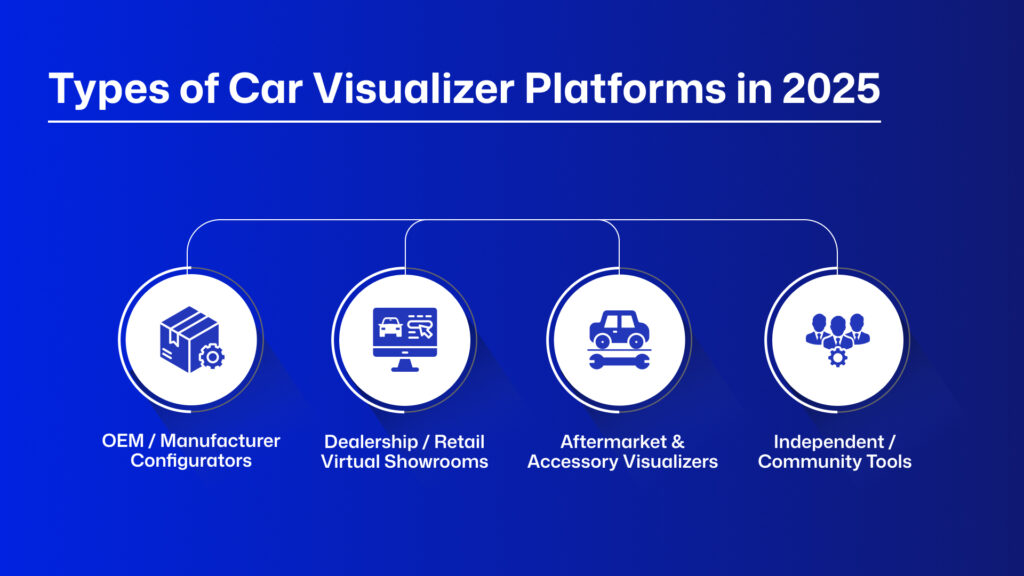
A. OEM / Manufacturer Configurators
Brands like BMW, Porsche, Renault, Mazda offer deep configurators: paint effects, wheel packages, interior trims. BMW M Visualizer gives >150 color filters, matte finishes, and virtual video walkaround experiences.
B. Dealership / Retail Virtual Showrooms
Platforms like RelayCars and London Dynamics power dealership-level car visualizer tools. They enable customization across multiple models, trim levels, and finish options, all publicly accessible.
C. Aftermarket & Accessory Visualizers
Tools such as vehicle-wheel visualizers let users add rims, tires, spoilers, or wrap previews. In Motion Brands offers a cloud-based wheel visualizer that combines aftermarket parts with actual customer vehicles.
D. Independent / Community Tools
Some online communities or indie developers offer lightweight car visualizer experiences, such as 3DTuning (community recommended), AI paint-try-on tools, or wrap preview systems shared on Reddit.
Step-by-Step: Using a Car Visualizer (User Perspective)
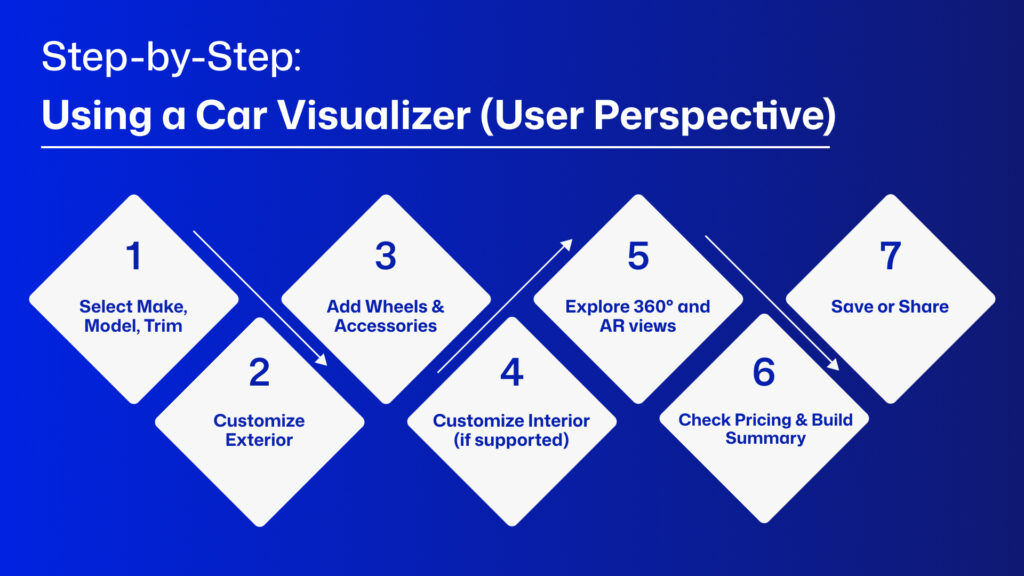
1. Select Make, Model, Trim
Begin by choosing your desired model, maybe a blue sedan or a particular SUV trim.
2. Customize Exterior
You can choose the color, however it may be, solid, matte, or ombre. See how it adapts to highlights and shadows as you rotate the model with Spyne number plate API.
3. Add Wheels & Accessories
Switch out wheels, rims, spoilers, roof racks, or performance kits if available.
4. Customize Interior (if supported)
You can choose the color of upholstery, stitching, seats, sunroof, and infotainment system.
5. Explore 360° and AR views
View your vehicle in 360 view, zoom in, and place it in an AR environment to watch it come to life in your driveway.
6. Check Pricing & Build Summary
If tied to a pricing engine, you’ll see live cost updates as you add premium paint, larger wheels, or luxury trims.
7. Save or Share
Download visuals, share a build link, or export configurations for quotes or sales rep follow-up.
Behind the Scenes: How People Build Car Visualizers
3D Modeling & Material Creation
Artists use CAD data or scanned models, then texture them with high-resolution material maps: paint flakes, leather stitching, carbon fiber grain.
Graphics Pipeline & Web Integration
Developers employ WebGL or native WebAssembly to render visuals quickly. Platforms like London Dynamics or Visartech power these real-time effects.
Performance Optimization
Features like LOD (level-of-detail), progressive loading, and environment HDRI lighting keep tools fast on mobile and low-power devices.
Data & Logic Layer
Configuration logic ties selections to option codes, pricing, and inventory constraints, keeping build realism in check.
Analytics Backend
Visualizers record clicks, color popularity, and session time, feeding marketing teams with actionable insights.
Spyne’s Role in Car Visualizer Technology
Spyne is a leading AI imaging company that’s helping reshape how cars are photographed, visualized, and presented across platforms. While not a traditional “customizer” for colors or trims, Spyne’s virtual car studio technology is widely used by auto retailers and SaaS platforms to offer dealership-level experiences that behave similarly to car visualizers.
Features that mimic car visualizers:
- Virtual background replacement
- AI-driven lighting and reflections
- 360° spin car imaging from guided phone shots
- Automatic number plate blurring and branding
- Studio-quality photo output that works in any environment
So if you’re wondering what is a car visualizer and whether Spyne qualifies, it’s fair to say Spyne bridges the gap between a visual configurator and a visual enhancer.
How Spyne Stands Out: Visual Accuracy & API Integration
Spyne is one of the few platforms offering car visualizer capabilities that scale. For B2B users, Spyne’s Car Visualizer API enables platforms to automatically generate real-time, visually enhanced car listings.
Key differentiators:
- Scalable for car marketplaces: Upload thousands of vehicle photos, enhance them to look studio-shot in seconds
- API access for SaaS or dealership platforms: Use Spyne to embed high-fidelity visuals across your ecosystem
- Fast onboarding and mobile-ready: Spyne even guides users to capture proper angles on mobile, creating consistent visual output
While Spyne doesn’t yet offer trim or paint customization like BMW or Porsche, it is increasingly used as a layer on top of traditional car visualizers, enhancing realism, branding, and consistency.
Benefits & Use Cases: Why Use a Car Visualizer
Consumers
- Visualize combinations without showroom visits
- Compare colors, trims, wheels, and interiors
- Save configurations and feel confident before purchase
Dealerships & OEMs
- Reduced photo shoot cost for every trim level
- Interactive marketing, better engagement online
- Real-time leads from builds and configuration abandonment
Aftermarket Shops & Accessory Retailers
- Show customers how part upgrades look in context
- Increase accessory sales via compelling visuals
- Build trust and confidence before order confirmation
Challenges and Limitations
- Not all models or trims may be supported
- Highly accurate finishes (e.g. specialized paint) may look slightly off
- AR experiences require mobile support and ambient lighting
- Pricing logic may differ across markets, always verify with dealer
Emerging Trends in 2025
VR and AR Integration
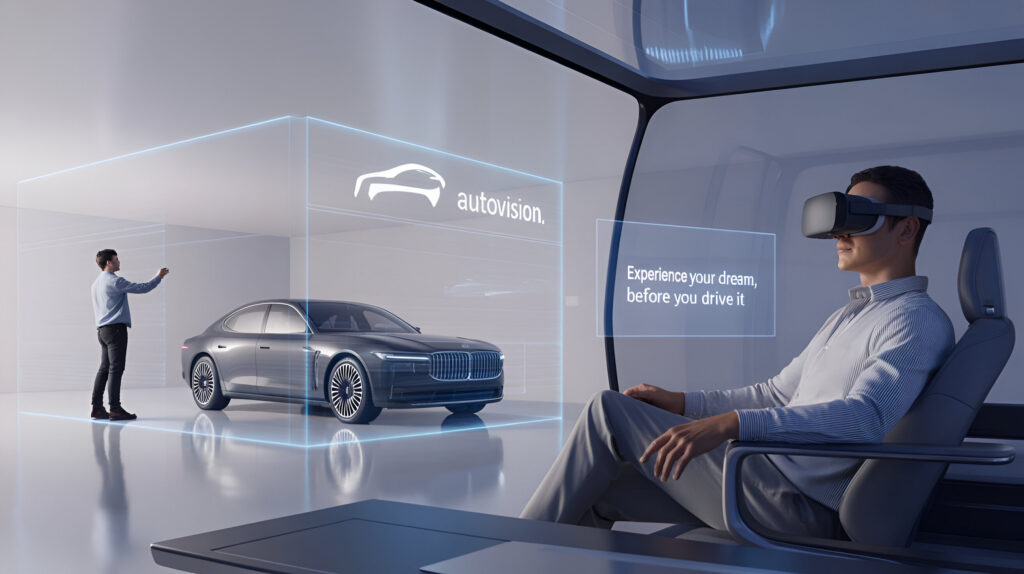
You can now use AR to “place” your configured car in your garage, walk around and experience scale firsthand. The next step? VR’s immersive walkaround inside virtual showrooms.
Personalized AI Suggestions
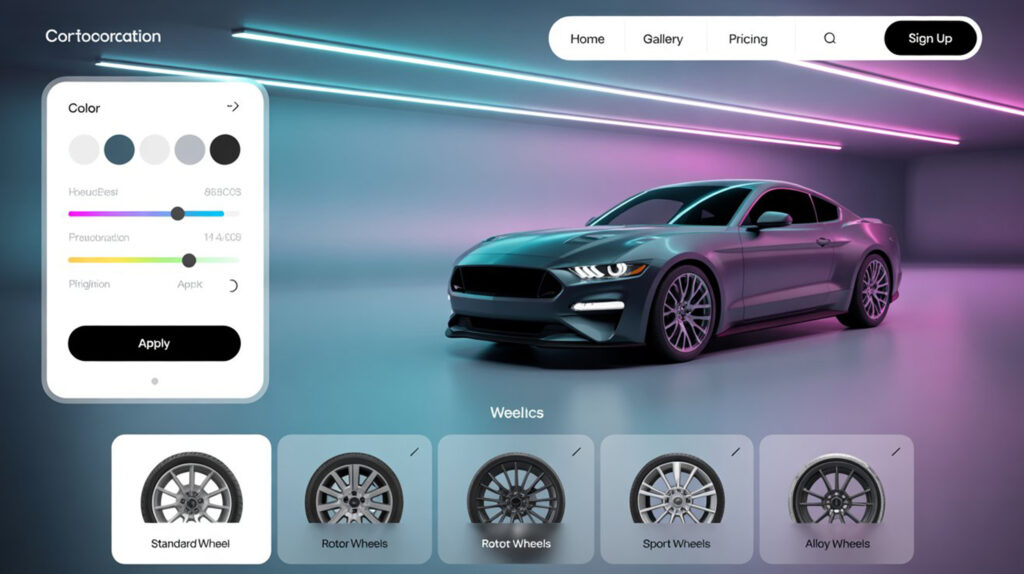
Based on earlier selections (e.g. matte green trim), systems may suggest complementary wheels, decal options, or matching interiors.
Analytics-Enriched CRM

Visualizer data now feeds CRM: if someone configures a red sports model with a premium interior, sales teams get tailored leads immediately.
Final Thoughts
So, what is a car visualizer? A car visualizer can be seen as a digital configurator, a virtual showroom that you can use to see your dream car come to life, and your interactive design studio. You can customize paint, wheels, interiors, and much more. After that you may explore the product in 3D or AR, without the need to go to a dealership physically. In 2025, many major brands are offering at least one type of car visualizer for improving engagement and helping others make better decisions at buying cars.

